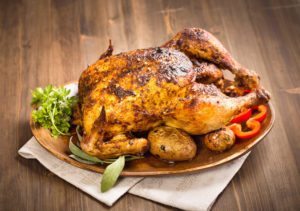By Maddy Davis, R.D.
Nutritional Benefits of Turkey & The History of Thanksgiving
One key element of a healthy eating pattern, as described in the 2015-2020 Dietary Guidelines for Americans, is to include a variety of nutrient-dense protein sources in your diet, such as lean meats, including turkey, which can provide a valuable source of protein and essential nutrients. Turkey is low in calories and fat and is a good source of selenium and B vitamins. Selenium is a trace mineral that is important for brain function, a healthy immune system, thyroid health, and fertility. Studies on B vitamins have also shown that these vitamins are essential for brain function, and for baby development during pregnancy. They are also crucial for cellular function, metabolism, energy production, and much more.
 Turkey is the centerpiece for our Thanksgiving feast in the U.S., but when and how did it become a Thanksgiving essential? According to tradition, in 1621, members of the native Wampanoag tribe and English colonists celebrated the first Thanksgiving by feasting on turkey, initiating the custom that we still follow to this day. In 1863, Abraham Lincoln declared Thanksgiving a national holiday and pardoned the first turkey, though the tradition of a presidential turkey pardon didn't officially catch on until recent decades.
Turkey is the centerpiece for our Thanksgiving feast in the U.S., but when and how did it become a Thanksgiving essential? According to tradition, in 1621, members of the native Wampanoag tribe and English colonists celebrated the first Thanksgiving by feasting on turkey, initiating the custom that we still follow to this day. In 1863, Abraham Lincoln declared Thanksgiving a national holiday and pardoned the first turkey, though the tradition of a presidential turkey pardon didn't officially catch on until recent decades.
Selecting a Turkey
When it comes to selecting a bird for a Thanksgiving meal, most people opt for whole turkeys that are conventionally raised, which means that the bird most likely was raised in an overcrowded crate or cage. Alternatively, you may opt for pasture-raised turkeys, such as heritage turkeys. These birds are given access to outdoor vegetation, raised in smaller numbers, and are given more time to grow and mature, which leads to a higher quality and more flavorful meat without added preservatives. When buying a turkey or chicken you may see the terms “pasture-raised” and “free-range,” which sounds like the same thing, but there’s a key difference between the two. The USDA requirements for “free range” simply mean that the animals are not housed in crates and cages and are given some outdoor access—there is no requirement on the amount of time spent outdoors or that the birds are provided space to roam. The only way to guarantee that your turkey has spent routine time in a natural pasture setting that was not overcrowded is to choose a bird labeled as “pastured-raised.”
Easy Ways to Incorporate Turkey into Your Diet
While most people are familiar with eating turkey on Thanksgiving and using turkey deli meat for sandwiches, there are many other ways to incorporate this healthful meat into your diet.
- Stuff bell peppers with ground or shredded turkey, rice, and your favorite spices.
- Spice up your average turkey sandwich by adding cranberry sauce, pesto, roasted red peppers, or sundried tomatoes.
- Add shredded or chopped turkey breast to soups, salads, or pastas.
- Use ground turkey to make a lighter take on meatballs or burgers.
Celebrate Thanksgiving this year by cooking a delicious, healthy feast that your family and friends will rave about! Download our featured ingredient card and recipe for Turkey with Cranberry-Molasses Glaze.


.png?width=1278&name=HHS-company%20logo-final%20(1).png)